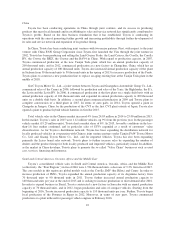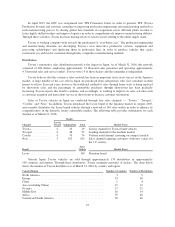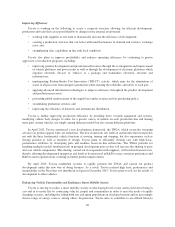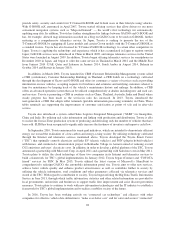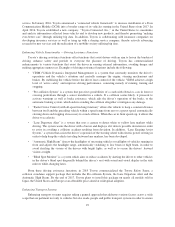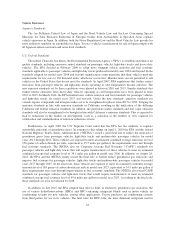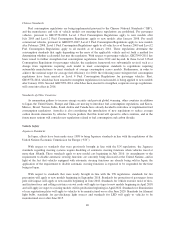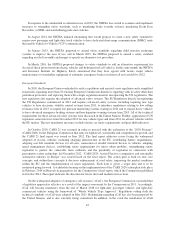Toyota 2015 Annual Report Download - page 37
Download and view the complete annual report
Please find page 37 of the 2015 Toyota annual report below. You can navigate through the pages in the report by either clicking on the pages listed below, or by using the keyword search tool below to find specific information within the annual report.Approximately 50% of Toyota’s unit sales in the United States during fiscal 2016 included a finance or
lease arrangement with Toyota. Because the majority of Toyota’s financial services operations are related to the
sale of Toyota vehicles, a decrease in vehicle unit sales may lead to a contraction of Toyota’s financial services
operations.
The worldwide financial services market is highly competitive. Toyota’s competitors in retail financing and
retail leasing include commercial banks, credit unions and other finance companies. Commercial banks and other
automobile finance subsidiary companies serving their parent automobile companies are competitors of Toyota’s
wholesale financing activities. Competitors in Toyota’s insurance operations are primarily national and regional
insurance companies.
For information on Toyota’s finance receivables and operating leases, please see “Operating and Financial
Review and Prospects — Operating Results — Financial Services Operations.”
Retail Financing
Toyota’s finance subsidiaries acquire new and used vehicle installment contracts primarily from Toyota
dealers. Installment contracts acquired must first meet specified credit standards. Thereafter, the finance
company retains responsibility for installment payment collections and administration. Toyota’s finance
subsidiaries acquire security interests in the vehicles financed and can generally repossess vehicles if customers
fail to meet their contractual obligations. Almost all retail financings are non-recourse, which relieves the dealers
from financial responsibility in the event of repossession. In most cases, Toyota’s finance subsidiaries require
their retail financing customers to carry automobile insurance on financed vehicles covering the interests of both
the finance company and the customer.
Toyota has historically sponsored, and continues to sponsor, special lease and retail programs by subsidizing
below market lease and retail contract rates.
Retail Leasing
In the area of retail leasing, Toyota’s finance subsidiaries acquire new vehicle lease contracts originated
primarily through Toyota dealers. Lease contracts acquired must first meet specified credit standards after which
the finance company assumes ownership of the leased vehicle. The finance company is generally permitted to
take possession of the vehicle upon a default by the lessee. Toyota’s finance subsidiaries are responsible for
contract collection and administration during the lease period. The residual value is normally estimated at the
time the vehicle is first leased. Vehicles returned to the finance subsidiaries at the end of their leases are sold by
auction. For example, in the United States, vehicles are sold through a network of auction sites as well as through
the Internet. In most cases, Toyota’s finance subsidiaries require lessees to carry automobile insurance on leased
vehicles covering the interests of both the finance company and the lessee.
Wholesale Financing
Toyota’s finance subsidiaries also provide wholesale financing primarily to qualified Toyota vehicle dealers
to finance inventories of new Toyota vehicles and used vehicles of Toyota and others. The finance companies
acquire security interests in vehicles financed at wholesale. In cases where additional security interests would be
required, the finance companies take dealership assets or personal assets, or both, as additional security. If a
dealer defaults, the finance companies have the right to liquidate any assets acquired and seek legal remedies.
Toyota’s finance subsidiaries also make term loans to dealers for business acquisitions, facilities
refurbishment, real estate purchases and working capital requirements. These loans are typically secured with
liens on real estate, other dealership assets and/or personal assets of the dealers.
32


